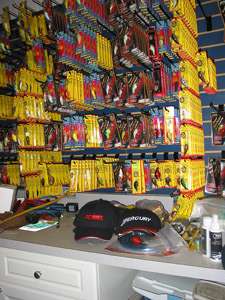
Organizing your fishing tackle is really no different than organizing anything else — you've got to have a system and stick with it. Discipline is as important as what system you use.
Elite Series angler and television personality Shaw Grigsby knows all about that. "I couldn't work if I wasn't organized. I don't claim to be perfect. You'll find a few things lying around. But generally I have a pretty good system and try to stick to it," he says. "I put things away when I get home and try my best to keep them in place when I'm not using them."
Grigsby has a lot of fishing tackle. He stores it in a 40 x 60 foot storage building which he's divided into three sections — freshwater, saltwater, and television show materials. "I like to keep those things separate. I don't use them at the same time, so why keep them in the same place?" he asks rhetorically.
On the freshwater side, he stores plastics, trailers, jigs and rigging materials in clear plastic tubs stacked on metal shelving. He first sorts by lure manufacturer, then by design, size, color or whatever else is appropriate. Each is carefully marked.
"It's nothing fancy, really. You can buy the tubs at any discount store. The important thing is to label them accurately and make sure you can see what's in them. That's important because you don't want to buy something if you already have it, but you also don't want to run out of something thinking you have plenty," he explains. "That's easy to do, especially with plastics. That's a bad deal either way."
His crankbaits, jerkbaits and spinnerbaits are handled a bit differently. All are made by Strike King, so breaking them down by manufacturer is not an issue.
"I hung slot board along the wall in one area. I hang the baits by running depth, size and color so I can see at a glance what I have. All the running depths are in one order — shallow to deep. The sizes all go from small to big, and the colors all run light to dark. That way if I want a particular model in a particular color, I know exactly where I need to look."
This detailed organizational scheme gives Grigsby several advantages. It allows him to swap tackle from his boat or truck directly to his storage building or vice versa with a minimum of effort. It also keeps his inventory current and available. This is not a guy who will run out of something. He'll know when he's running out while there's still time to do something about it.
Now this system might be too much for the average angler. Most of us don't have as many fishing lures as Shaw Grigsby. We don't need a 40 x 60 building to store them in. Still, organization is as important to us as it is to him.
Not many of us can afford to buy things we already own. And few of us want to run out of something we need. The idea is to stay current with a minimum of time and expense and to have what we need when we need it. Grigsby's basic system will work for anyone.




